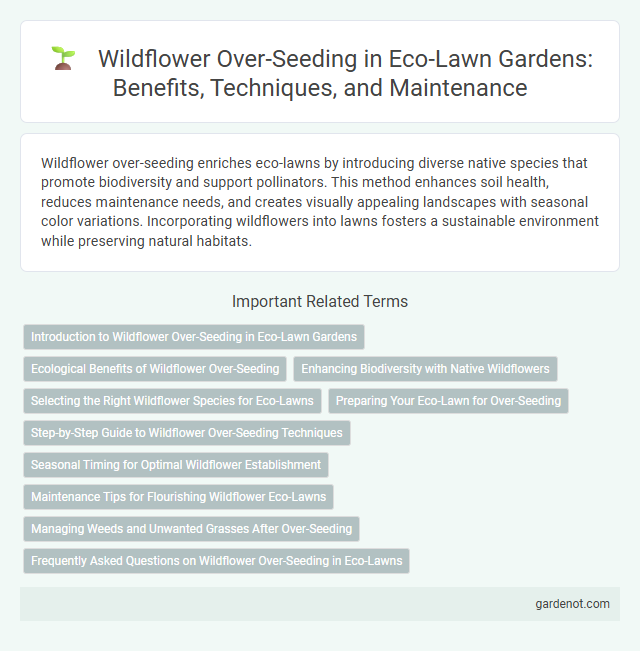Wildflower over-seeding enriches eco-lawns by introducing diverse native species that promote biodiversity and support pollinators. This method enhances soil health, reduces maintenance needs, and creates visually appealing landscapes with seasonal color variations. Incorporating wildflowers into lawns fosters a sustainable environment while preserving natural habitats.
Introduction to Wildflower Over-Seeding in Eco-Lawn Gardens
Wildflower over-seeding in eco-lawn gardens enhances biodiversity by introducing native wildflower species that improve soil health and support pollinator populations. This method increases the resilience of lawns to drought and pests, reducing the need for synthetic fertilizers and pesticides. Integrating wildflowers creates vibrant, sustainable landscapes that contribute to local ecosystems and promote ecological balance.
Ecological Benefits of Wildflower Over-Seeding
Wildflower over-seeding enhances biodiversity by providing essential habitats and food sources for pollinators such as bees and butterflies, supporting overall ecosystem health. This practice improves soil quality through natural nutrient cycling and reduces the need for chemical fertilizers, promoting sustainable land management. Over-seeding with wildflowers also increases plant diversity, which helps control erosion and supports a resilient, self-sustaining eco-lawn.
Enhancing Biodiversity with Native Wildflowers
Wildflower over-seeding significantly enhances biodiversity by introducing native wildflowers that support local pollinators, birds, and beneficial insects. These native species improve soil health and create habitats that foster ecological balance in eco-lawns. Choosing region-specific wildflowers ensures resilience and sustainability, contributing to a vibrant and thriving ecosystem.
Selecting the Right Wildflower Species for Eco-Lawns
Selecting the right wildflower species for eco-lawn over-seeding involves choosing native, drought-tolerant varieties that complement existing grass and local soil conditions. Species like Black-eyed Susan (Rudbeckia hirta), Purple Coneflower (Echinacea purpurea), and Wild Bergamot (Monarda fistulosa) enhance biodiversity while supporting pollinators. Proper species selection ensures a balanced, low-maintenance eco-lawn that thrives with minimal irrigation and sustains local wildlife habitats.
Preparing Your Eco-Lawn for Over-Seeding
Preparing your eco-lawn for wildflower over-seeding involves first mowing the existing grass closely and removing any debris to ensure optimal seed-to-soil contact. Lightly scarify the surface to create small gaps that improve seed germination and water absorption. Ensuring the soil is moist but not waterlogged before broadcasting the wildflower seeds enhances establishment and promotes a vibrant, biodiverse lawn.
Step-by-Step Guide to Wildflower Over-Seeding Techniques
Wildflower over-seeding enhances biodiversity by introducing a diverse mix of native seeds directly onto existing turf, promoting vibrant ecological benefits. Begin by preparing the soil with light raking to create optimal seed-to-soil contact, then evenly distribute a carefully selected blend of wildflower seeds tailored to your local climate and soil type. Maintain consistent moisture through regular watering and avoid heavy foot traffic during germination to ensure robust growth and long-lasting wildflower establishment.
Seasonal Timing for Optimal Wildflower Establishment
Over-seeding wildflowers in an eco-lawn is most effective during early spring or late fall when soil temperatures range between 50degF and 65degF, promoting optimal seed germination. Choosing these periods aligns with natural rainfall patterns and reduces weed competition, enhancing wildflower establishment and growth. Proper seasonal timing ensures a vibrant, diverse floral display, supporting pollinators and improving overall lawn biodiversity.
Maintenance Tips for Flourishing Wildflower Eco-Lawns
Regular watering during the first six weeks after wildflower over-seeding ensures strong seed germination and root development. Mowing should be done at a higher setting, around 4 inches, to allow wildflowers to grow without being cut down prematurely. Removing weeds manually or using targeted herbicides helps reduce competition, promoting a vibrant and diverse wildflower eco-lawn.
Managing Weeds and Unwanted Grasses After Over-Seeding
Wildflower over-seeding enhances biodiversity by introducing native species that naturally outcompete weeds and unwanted grasses, reducing reliance on chemical herbicides. Establishing a dense wildflower canopy creates shade and limits soil resources, which suppresses weed germination and growth. Regular monitoring and targeted spot treatments ensure that invasive plants do not disrupt the delicate ecosystem balance promoted by the wildflower over-seed.
Frequently Asked Questions on Wildflower Over-Seeding in Eco-Lawns
Wildflower over-seeding in eco-lawns enhances biodiversity by introducing native species that support pollinators and improve soil health. Frequently asked questions address optimal seeding times, seed mix ratios, and maintenance practices to ensure successful establishment and long-term sustainability. Proper site preparation, selecting region-specific wildflower varieties, and monitoring for invasive species are crucial steps for a thriving eco-lawn ecosystem.
Wildflower over-seed Infographic

 gardenot.com
gardenot.com